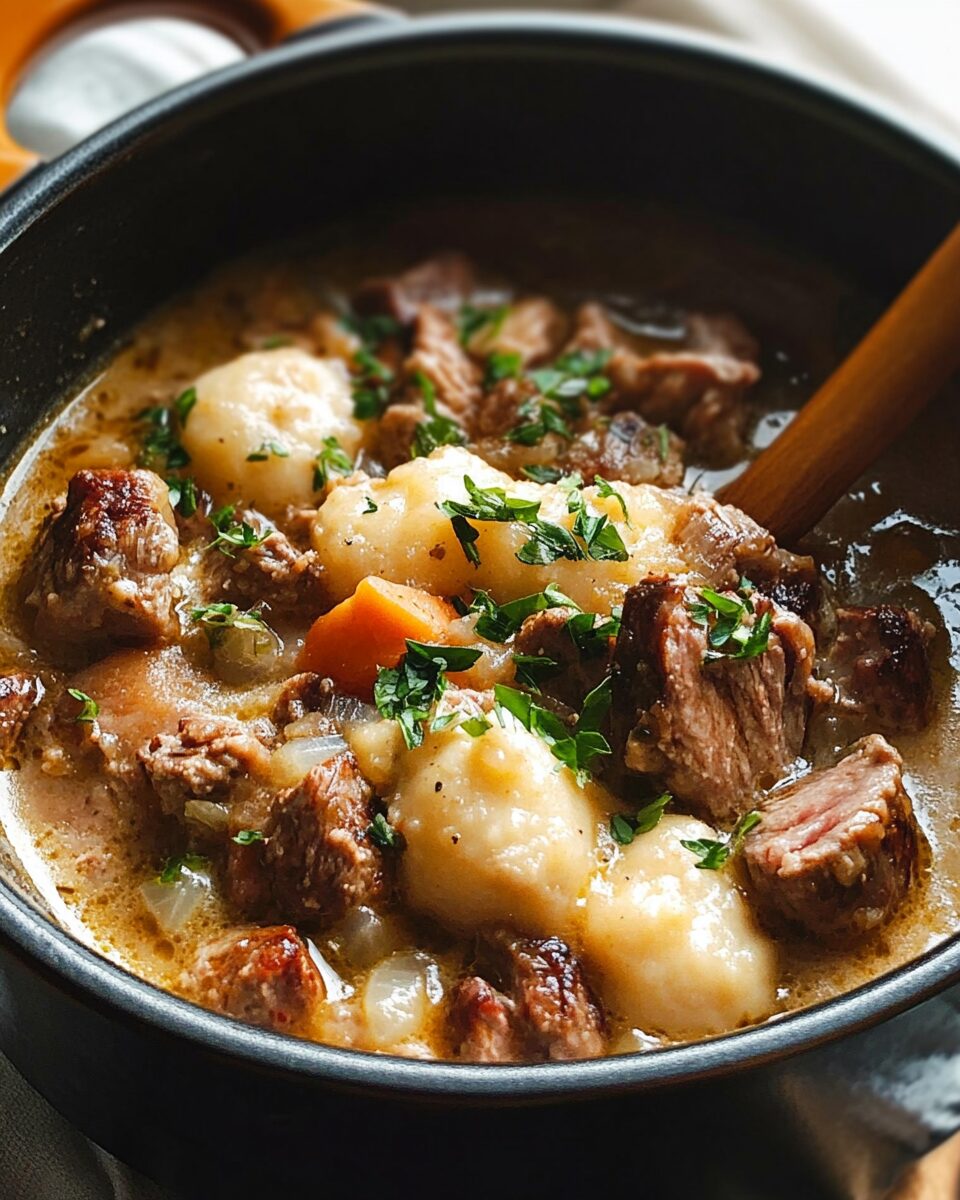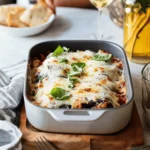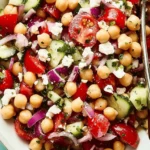This Irish Lamb Stew is a hearty and flavorful dish, perfect for St. Patrick’s Day or any time you’re craving a comforting meal. Tender lamb chunks are simmered with fresh vegetables, crisp bacon, and Guinness beer, creating a rich and satisfying stew.
FULL RECIPE:
Ingredients
- 2 lb lamb stew meat, cubed
- 2 lb Yukon potatoes, quartered
- 2 cups carrots, chopped into quarters
- 1 cup celery, thinly sliced
- 2 cups baby Bella mushrooms, whole
- 1 onion, diced
- 4 cloves garlic, minced
- 3 tbsp tomato paste
- 1 tbsp olive oil
- 4 slices bacon, cut into small pieces
- 1 can Guinness beer
- 32 oz beef broth
- Salt and pepper to taste
- Fresh thyme
Directions
- Heat the olive oil in a Dutch oven over medium heat. Add the bacon and cook until crispy, about 5 minutes. Remove the bacon and set aside, leaving the fat in the pot.
- Season the lamb generously with salt and pepper. In the same pot, brown the lamb on all sides. Once browned, remove the lamb and set aside.
- Add the diced onion and minced garlic to the pot. Sauté until light brown and fragrant, approximately 2-3 minutes.
- Incorporate the chopped carrots and sliced celery. Cook until the vegetables have softened, about 5 minutes.
- Stir in the tomato paste and pour in the Guinness beer. Use a spatula to scrape up any browned bits from the bottom of the pot. Allow the beer to reduce for about 2 minutes.
- Pour in the beef broth and stir well. Return the browned lamb and crispy bacon to the pot. Add fresh thyme, quartered potatoes, and whole mushrooms on top. Do not stir; the potatoes and mushrooms should sit on top of the meat. Cover the pot and cook on medium heat for 1 hour and 45 minutes to 2 hours.
- Once the stew is done, garnish with additional fresh herbs if desired, and serve hot.
Nutrients Per serving:
- Calories: 398 kcal
- Carbohydrates: 36 g
- Protein: 37 g
- Fat: 12 g
- Saturated Fat: 4 g
- Polyunsaturated Fat: 1 g
- Monounsaturated Fat: 5 g
- Cholesterol: 99 mg
- Sodium: 779 mg
- Potassium: 1551 mg
- Fiber: 6 g
- Sugar: 6 g
- Vitamin A: 7329 IU
- Vitamin C: 37 mg
- Calcium: 77 mg
- Iron: 5 mg
History of Irish Lamb Stew
Irish Lamb Stew is a dish deeply rooted in the culinary traditions of Ireland. Dating back centuries, it was originally a meal created out of necessity, using simple, locally available ingredients such as lamb, potatoes, onions, and carrots. The Irish countryside provided an abundance of sheep, making lamb a common protein source, while root vegetables were easy to grow and store throughout the year. Traditionally, Irish stews were cooked over open fires in large pots, allowing the flavors to develop slowly while the meat became tender.
Why Irish Lamb Stew is a Popular Dish
Irish Lamb Stew is well-loved not only in Ireland but around the world due to its rich, comforting taste and nutritional value. The dish is:
- Hearty and Filling – With chunks of tender lamb, potatoes, and vegetables, this stew is a complete meal on its own.
- Perfect for Cold Weather – The warm, slow-cooked broth is ideal for chilly nights, making it a staple in many households during the winter months.
- Easy to Prepare – While it requires some patience due to the slow cooking process, the actual preparation is straightforward, making it an excellent meal for both beginner and experienced cooks.
- Rich in Nutrients – Packed with protein, fiber, vitamins, and minerals, Irish Lamb Stew is both delicious and nourishing.
Variations of Irish Lamb Stew
Although the traditional recipe remains popular, there are many regional and personal variations of Irish Lamb Stew that introduce new flavors and textures. Some common adaptations include:
1. Guinness Irish Stew
One of the most popular modern variations, this version incorporates Guinness beer into the broth. The dark beer adds a rich, malty depth that enhances the natural flavors of the lamb and vegetables.
2. Slow Cooker Irish Lamb Stew
For a hands-off approach, many people choose to prepare this dish in a slow cooker. This method allows the lamb to become even more tender and makes it convenient for busy individuals who want a home-cooked meal without constant supervision.
3. Creamy Irish Stew
Some variations include a creamy base by adding heavy cream or mashed potatoes to thicken the broth. This creates a richer, more indulgent dish.
4. Spiced Irish Stew
While traditional Irish stews keep seasonings simple, some modern adaptations include spices such as paprika, cumin, or even a touch of cayenne pepper to give the dish a slight kick.
5. Vegetarian Irish Stew
For those who prefer a meatless version, replacing lamb with hearty mushrooms, lentils, or chickpeas still creates a flavorful and filling stew while maintaining the essence of the dish.
Tips for Making the Best Irish Lamb Stew
To create an authentic and flavorful Irish Lamb Stew, consider the following tips:
- Choose the Right Cut of Lamb – The best cuts for stew include lamb shoulder, neck, or shank, as they contain enough fat and connective tissue to break down during cooking, resulting in tender and flavorful meat. Avoid lean cuts, as they can become tough when slow-cooked.
- Sear the Meat for Added Flavor – While some recipes call for simply adding the lamb directly to the broth, taking the time to sear the meat in a hot pan first will enhance the depth of flavor. Browning the meat creates caramelization, which adds richness to the stew.
- Use Fresh Herbs – Thyme, rosemary, and bay leaves are classic herbs that complement the flavor of the lamb. Fresh herbs offer a more vibrant taste compared to dried ones, but dried herbs can still work well if fresh ones are unavailable.
Layer the Ingredients Correctly
To ensure all ingredients cook properly without becoming too mushy or undercooked, follow this order:
- Sear the lamb and cook onions and garlic first – This builds the base flavor.
- Add liquid and seasonings – Allow the flavors to meld before adding vegetables.
- Add root vegetables later – Potatoes and carrots should be added halfway through cooking to prevent them from becoming overly soft.
- Simmer on Low Heat- A slow, gentle simmer allows the flavors to develop and the meat to become fork-tender. Cooking the stew at too high a temperature can cause the lamb to become tough and dry.
- Let the Stew Rest Before Serving- Allowing the stew to sit for 10-15 minutes after cooking helps the flavors meld together. Some people even recommend making it a day in advance, as stews often taste better the next day once the flavors have fully developed.
What to Serve with Irish Lamb Stew
Irish Lamb Stew is a complete meal on its own, but pairing it with the right sides can enhance the dining experience. Here are some traditional and complementary accompaniments:
1. Irish Soda Bread
A classic side for any Irish stew, soda bread is slightly dense with a crispy crust, perfect for soaking up the rich broth.
2. Mashed Potatoes
While the stew already contains potatoes, some people enjoy serving it over a bed of creamy mashed potatoes for extra comfort.
3. Buttered Cabbage
Steamed or sautéed cabbage with a touch of butter and seasoning complements the flavors of the stew while adding a bit of crunch.
4. Roasted Root Vegetables
For a heartier meal, serve the stew with a side of roasted parsnips, turnips, or beets.
5. A Pint of Guinness
If you’re preparing this stew for a special occasion, enjoying it with a pint of Guinness beer enhances the Irish experience.
Why Irish Lamb Stew is Perfect for St. Patrick’s Day
Irish Lamb Stew is a staple dish for St. Patrick’s Day celebrations, as it represents the heart and soul of Irish cuisine. The use of local ingredients, combined with slow-cooked goodness, makes it the perfect dish to share with family and friends. This stew is also a great way to honor Irish heritage while enjoying a delicious, home-cooked meal. Whether served at a festive gathering or as a cozy meal on a chilly evening, it embodies the warmth and tradition of Ireland.
Conclusion
Irish Lamb Stew is more than just a meal; it is a celebration of Irish history, culture, and tradition. This dish, once a simple peasant meal, has evolved into a cherished comfort food enjoyed by people worldwide. The combination of tender lamb, hearty vegetables, and a flavorful broth makes it a dish worth savoring. Whether you choose a classic version, a slow cooker adaptation, or a Guinness-infused variation, Irish Lamb Stew is a recipe that will always bring warmth and satisfaction to the table.






